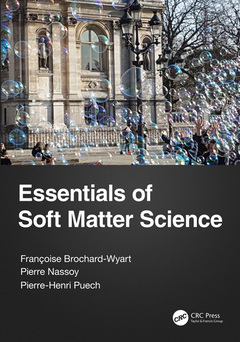Essentials of Soft Matter Science
Auteurs : Brochard-Wyart Francoise, Nassoy Pierre, Puech Pierre-Henri

?Choice Outstanding Title?
Authored by world-leading physicists, this introductory textbook explores the basic principles of polymers, colloids, liquid crystals, wetting, and foams. It is a practical ?toolbox? for readers to acquire basic knowledge in the field and facilitate further reading and advanced courses. Undergraduate students in physics, biology, and the medical sciences will learn the basics of soft matter physics, in addition to scaling approaches in the spirit of the Nobel prize laureate in physics in 1991, Pierre-Gilles de Gennes, the inventor of soft matter physics and close collaborator to author Françoise Brochard-Wyart.
Features:
- Accessible and compact approach
- Contains interesting examples from everyday life (including the Paris Metro, a water spider, a gecko, and duck feathers)
- Accompanied by additional exercises to enhance understanding available for download from the CRC Press website
"Three physicists (one theoretician; two experimentalists, one in biophysics) adopt an intuitive and practical style to present the fundamentals of soft matter physics. Make no mistake: the style is accessible and revealing, but the underlying science is profound. Brochard-Wyart (Sorbonne Univ.) was a collaborator and former student of the late Pierre-Gilles de Gennes (originator of soft matter physics, 1991 Nobel laureate in physics). The authors lay claim to the style of de Gennes (and reference their class notes) in their method of presentation, including its organization and range of topics.
There are two broad groupings: chapters 1?7 cover definition and characterization of soft matter, then interfaces, phase transitions, liquid crystals, surfactants, and polymers, offering simple calculations (order of magnitude estimates) and scaling law arguments. Part 2 (chapters 8?10) covers a range of applications: self-cleaning surfaces, biomimetic adhesion, optical applications, and biological applications from DNA to tissue engineering. Many examples are based on everyday household phenomena. Each chapter provides a short bibliography. Any student (primarily in physics, biology, chemistry, and engineering) or researcher will enjoy reading this unique book. To benefit fully, readers need some background in electricity and magnetism, chemistry, fluid mechanics, statistical mechanics, and thermodynamics. This reader has rarely encountered a book so accessible, yet so thought provoking.
Summing Up:Highly recommended. Lower-division undergraduates through professionals."
?J. Lambropoulos, University of Rochester in CHOICE October 2020).
1.Introduction. 2. Soft Matter. 3. Phase Transitions. 4. Interfaces. 5. Liquid Crystals. 6. Surfactants. 7. Polymers. 8. Soft Matter in Everyday Life. 9. Soft Matter Technology. 10. Soft Matter in Biology. 11. Conclusion.
Françoise Brochard-Wyart is a theoretical physicist in soft matter physics and Professor at Sorbonne University and the Institut Curie, France. She studied at École Normale Supérieure de Cachan. After a PhD in Liquid Crystals under the supervision of Pierre-Gilles De Gennes, she studied polymer physics and wetting before moving to biophysics. She is a member of Institut Universitaire de France. She was awarded the Jean Ricard Prize from the French Physical Society in 1998.
Pierre Nassoy is an experimentalist physicist and a CNRS senior scientist at the Institut d’Optique d’Aquitaine in Bordeaux, France. He studied at Ecole Supérieure de Physique et Chimie Industrielles de Paris (ESPCI) and obtained an engineering diploma. He was junior CNRS scientist interested in cell biophysics at the Institut Curie until 2012.
Pierre-Henri Puech is an experimentalist (bio)physicist and an Inserm junior scientist at the Laboratoire Adhésion et Inflammation (LAI) in Marseille, France. He studied at Ecole Supérieure de Physique et Chimie Industrielles de Paris (ESPCI) and obtained an engineering diploma. His research interests center around cell biophysics, in particular in the context of mechanotransduction in T-cell recognition.
Date de parution : 08-2019
17.8x25.4 cm
Date de parution : 08-2019
17.8x25.4 cm
Thèmes d’Essentials of Soft Matter Science :
Mots-clés :
Counter Clockwise; PDMS Chain; Condensed Matter Physics; Optical Trap; Surfactant; Pierre Gilles De Gennes; Soft Condensed Matter Science; Newtonian Black Film; Soft Materials; Lyotropic Liquid Crystals; Liquid Crystal; Tobacco Mosaic Virus; wetting; Soap Film; Silex; soft matter physics; Molecular Cuisine; soft matter; Nematic Isotropic Transition; soft material; Hamaker Constant; PDMS; biology; DNA Molecule; physics; Liquid Gas Transition; medicine; Nematic Order Parameter; foam; Contact Angle; colloids; Super Hydrophobic; polymer; Order Parameter; Photonic Crystal; Coexistence Curve; Critical Exponents; Lb Film



